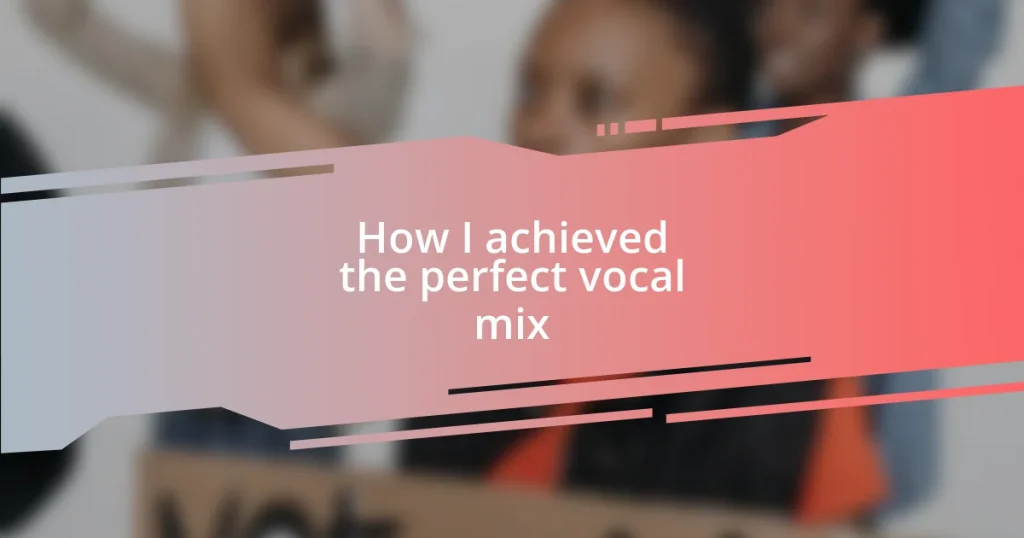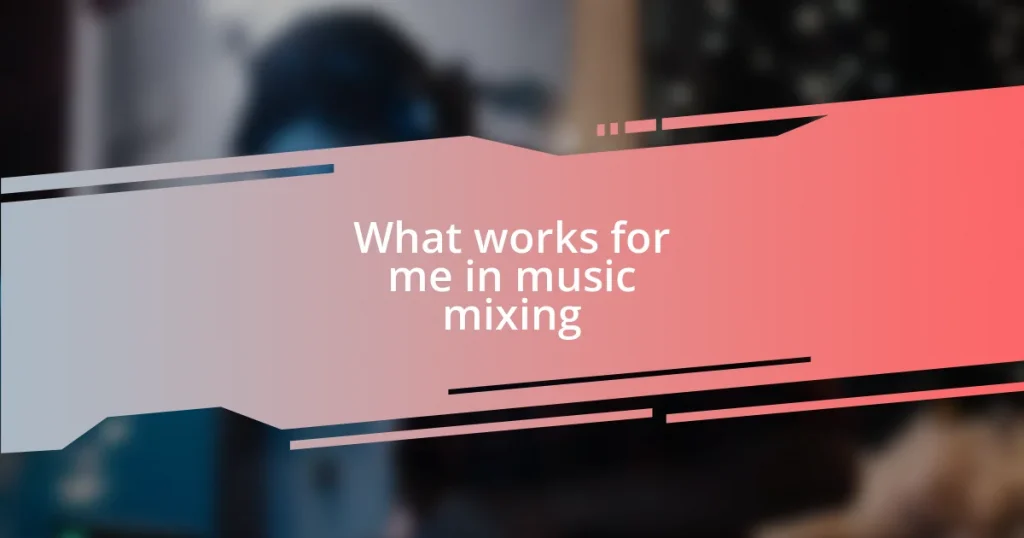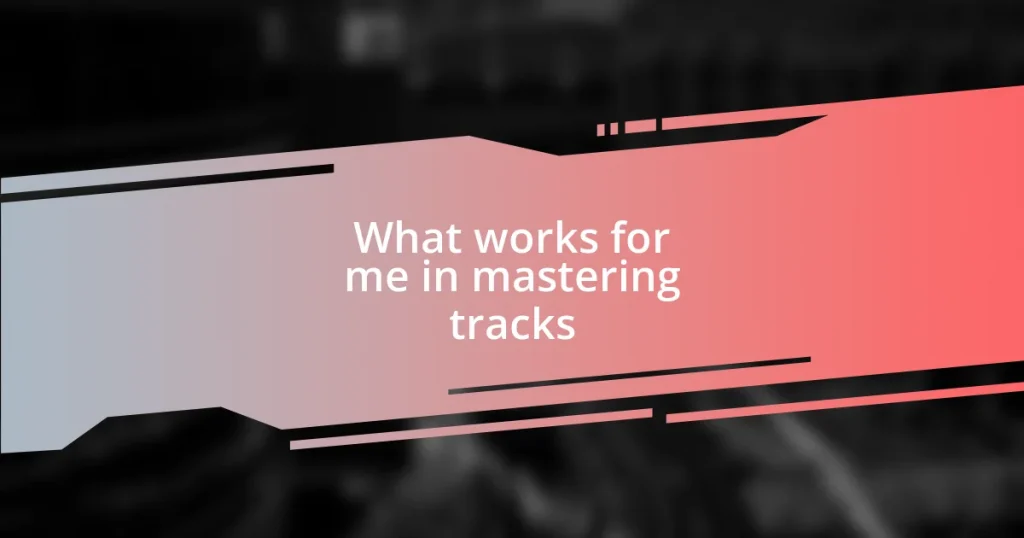Key takeaways:
- Effective vocal mixing techniques, including EQ, compression, and reverb, are essential for achieving clarity and emotional impact in recordings.
- Choosing the right microphone based on type, pattern, and purpose significantly enhances vocal quality and connection to the music.
- Finalizing the mix and mastering involves careful adjustments and listening across different environments to ensure the track translates well on various playback systems.
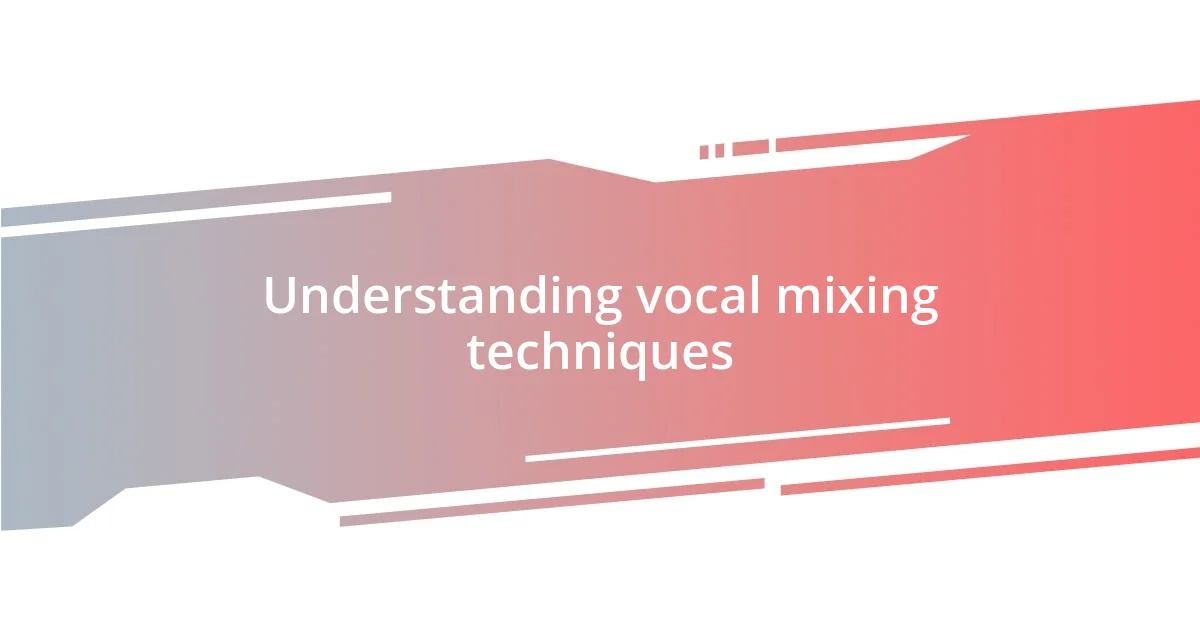
Understanding vocal mixing techniques
When diving into vocal mixing techniques, I often find myself reminiscing about my early recording days. I remember a time when I struggled to make my voice stand out—I just didn’t know how to balance effects like EQ and reverb. Have you ever felt your vocals were lost in the mix? Discovering the right techniques, such as using equalization to carve out space for the vocals, transformed my mixing game.
Compression is another fundamental technique that I discovered through trial and error. I vividly recall a project where my vocals sounded too dynamic—some parts were way too loud while others barely registered. Once I learned to apply compression, suddenly my vocals had more presence and a better connection to the instrumentation. It was a game changer that made me realize the power of controlled dynamics. Do you really know how compression can shape the emotional impact of your vocals?
Lastly, I can’t stress enough the importance of panning and layering harmonies. In one of my favorite tracks, I experimented with double-tracking my vocals and panning them slightly left and right. The result was a fuller sound that added depth and richness, drawing listeners in. I often ask myself: how much does vocal layering contribute to the storytelling of a song? The answer is profound—it brings emotions to life, making your audience feel every word deeply.
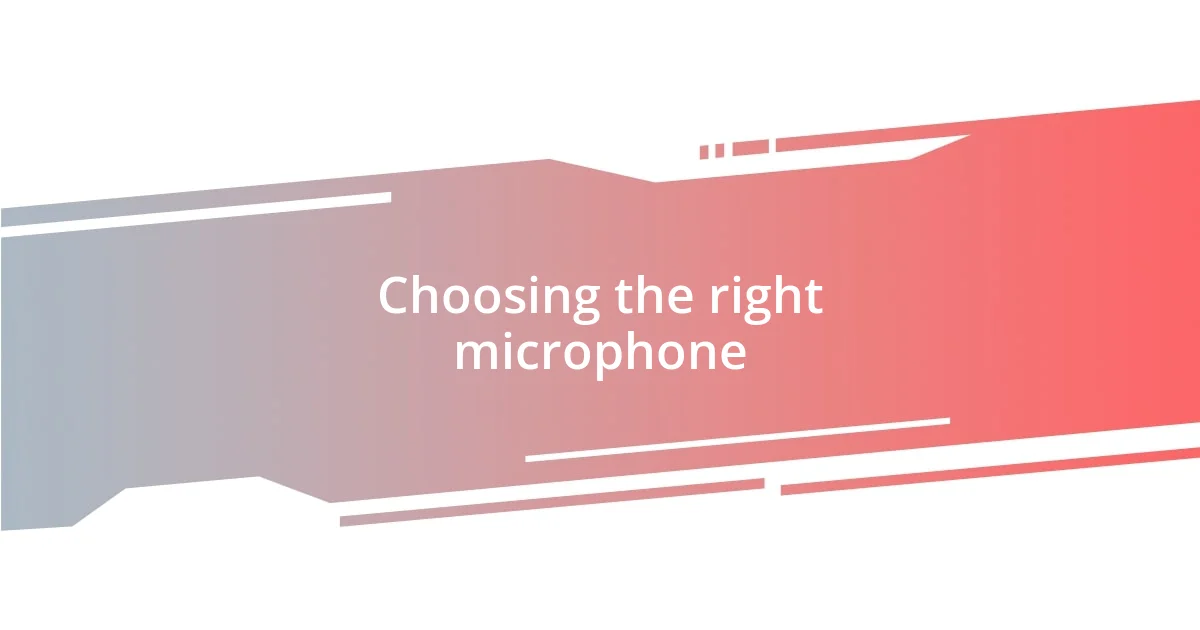
Choosing the right microphone
Choosing the right microphone can truly transform the quality of your vocal recordings. I remember the first time I utilized a condenser microphone; it was as if a veil had been lifted from my voice. The clarity and warmth it provided made me feel more connected to the music. I’ve learned the hard way that not all microphones suit every voice.
When considering a microphone, here are key factors to keep in mind:
- Type: Decide between dynamic and condenser. Dynamic mics are great for live settings, while condensers shine in studio environments.
- Pattern: Pay attention to polar patterns. Cardioid mics pick up sound primarily from the front, which minimizes background noise.
- Budget: Find something that fits your budget but doesn’t skimp on quality; there are excellent options at various price points.
- Testing: If possible, test different mics to see how they respond to your voice; you might be surprised by the difference.
- Purpose: Consider the genre you’re working in—some mics complement certain styles better than others.
These considerations not only elevate the recording quality but also enhance your emotional connection to the music. After choosing the right mic, I felt more empowered during recording sessions, allowing me to focus on delivering the best performance possible.
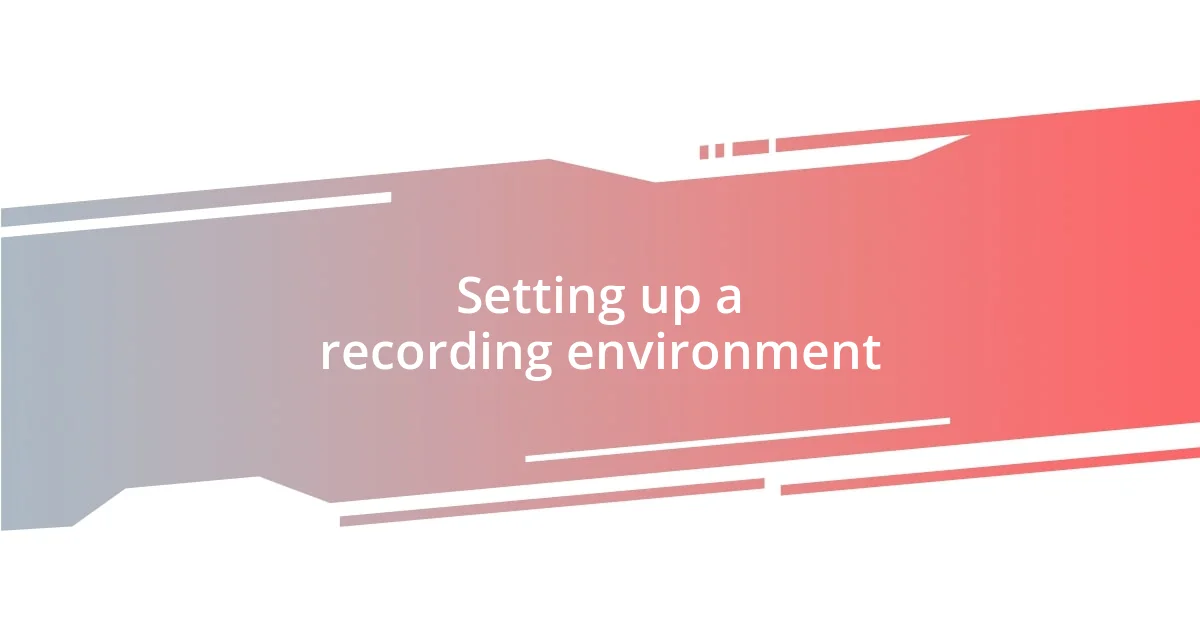
Setting up a recording environment
Setting up a recording environment is arguably as crucial as choosing the right microphone. I learned this firsthand when I transitioned from recording in a mostly empty room to a dedicated space designed for sound. The difference was staggering! I could finally hear the nuances in my vocals, something that felt like a luxury I’d been missing. If you’ve ever tried to mix in a noisy or echo-prone space, you know exactly how frustrating it can be.
Acoustic treatment is one aspect that often goes overlooked. In my case, I started with DIY solutions; I hung thick blankets on the walls and placed foam panels in the corners. It created a more controlled environment that minimized unwanted reflections. Have you considered how much your room can affect what you hear? I can’t emphasize enough how critical it is to optimize your recording space.
Now, let’s talk about the setup itself. I learned early on to position my microphone correctly to avoid any room noise. Placing it away from walls and reflective surfaces made a world of difference. It’s a small tweak, but it can dramatically affect your vocal quality. Each tiny adjustment contributes to that perfect mix you’re aiming for.
| Setup Element | Impact |
|---|---|
| Room Treatment | Improves clarity and reduces unwanted echoes. |
| Microphone Placement | Affects the quality of the recorded vocals and minimizes ambient noise. |
| Background Noise Control | Ensures that the focus remains on the vocals, maintaining emotional impact. |

Applying EQ to enhance vocals
Applying EQ effectively can completely transform vocal tracks, and I’ve seen it firsthand in my mixing journey. I remember the first time I boosted the high frequencies on my vocals; it felt like I had uncovered hidden layers of brilliance. Suddenly, the vocals shone through the mix, capturing the listener’s attention in a way I hadn’t achieved before.
A common misconception is that more EQ always leads to better sound, but I’ve learned it’s about the right adjustments. For instance, I often cut some low frequencies to eliminate muddiness; this gives the vocal a clearer presence. Have you ever felt that your vocals vanish in a mix? That was me before I embraced precise EQ adjustments. Finding that sweet spot where the voice shines without overpowering other elements is a balancing act worth mastering.
In my experience, using a notch filter to reduce problem frequencies can work wonders. I distinctly recall mixing a track where my vocal’s harshness in the 2kHz range was distracting. By dialing back that frequency, the result was remarkably smoother. It’s like fine-tuning an instrument—you want each element to play harmoniously. Remember, EQ isn’t just about boosting; it’s also about sculpting the sound to fit the overall mix. It’s these nuances that contribute to achieving that perfect vocal mix.
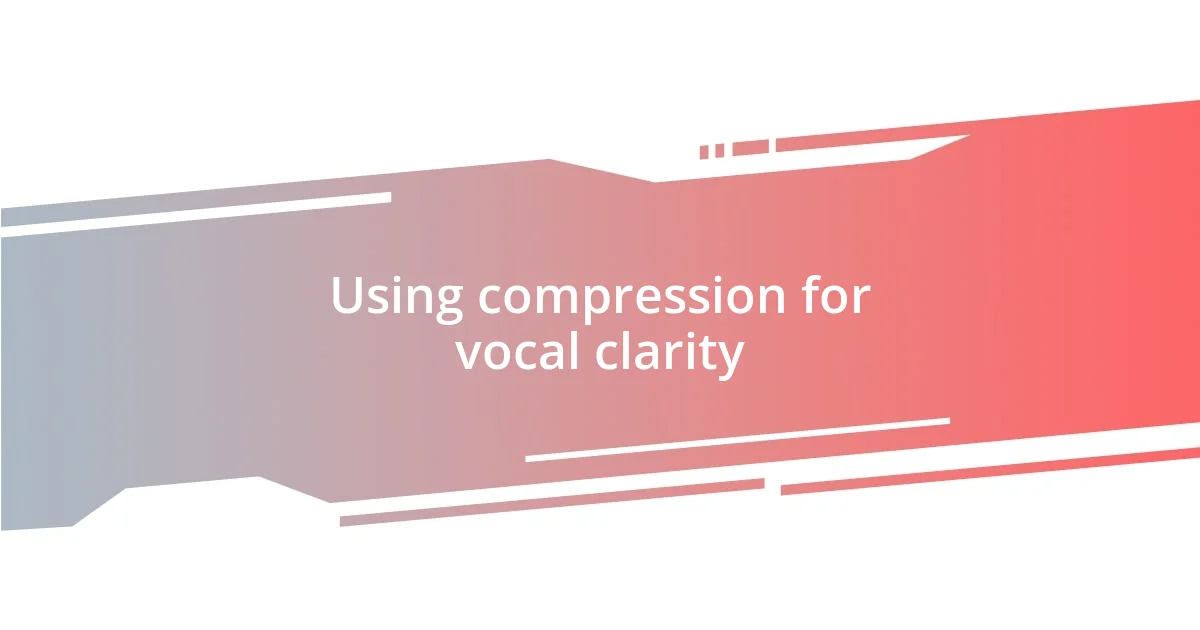
Using compression for vocal clarity
Using compression on vocals can truly elevate clarity, and I’ve witnessed its magic in countless mixing sessions. Early on, I struggled with dynamic fluctuations in my vocal recordings—sometimes I sounded like a whisper, and other times, I was nearly shouting. When I started experimenting with compression, it felt like I finally added a secret weapon to my mixing toolkit. Have you ever noticed how certain vocalists maintain such a consistent presence in a mix? That’s often the power of compression at work.
Setting the right threshold and ratio was a breakthrough moment for me. I remember the first time I used a compressor to level out my vocal track; I watched as it tamed those wild peaks, making my voice sit perfectly within the instrumental bed. This control not only made my performance sound more polished but also brought out the emotional nuances within my delivery. It’s fascinating how a small adjustment in the compressor can make you feel the intensity of the lyrics more profoundly.
Moreover, I discovered that adding just a touch of makeup gain after compressing can brighten up the overall sound. There was one particular song where I had a heartfelt ballad; after compressing it, my vocals took on a new life—they felt more intimate and engaging. Have you experienced that transformative moment when your mix just clicks? It often happens when compression smooths out the dynamics while bringing clarity, allowing the sincerity of the performance to shine through. Through trial and error, I found that the right compression settings can indeed be a game-changer for vocal clarity.

Adding reverb for space
Adding reverb to vocals can create an incredible sense of space in a mix, something I’ve come to appreciate deeply throughout my mixing journey. I remember the first time I added a touch of reverb to a vocal track; it felt as if the singer had stepped out of a small booth and into a grand hall. That awareness of depth changes everything—suddenly, instead of just hearing the voice, you feel the atmosphere it inhabits.
The key to using reverb effectively lies in subtlety. I often find myself starting with a small amount and gradually increasing it until I achieve that perfect sonic environment. It’s like chasing a feeling; you can almost sense when the balance is right, and too much reverb can drown the lyrics, making them hard to decipher. Have you ever struggled to find that sweet spot? I certainly have, especially in a busy mix where less is often more.
One memorable track featured a vocalist with a soft, emotive delivery. Initially, the reverb overwhelmed the clarity, making the words a foggy whisper. But after adjusting the decay time and mixing the effect in gently, the vocals took on a luminous quality. They floated on top of the instrumental without losing presence—like an ethereal breeze bringing the emotion alive. This experience taught me that reverb isn’t just about adding echo; it’s about sculpting space that breathes with the performance. Feel free to experiment—after all, finding the right reverb can turn a good mix into something truly immersive.
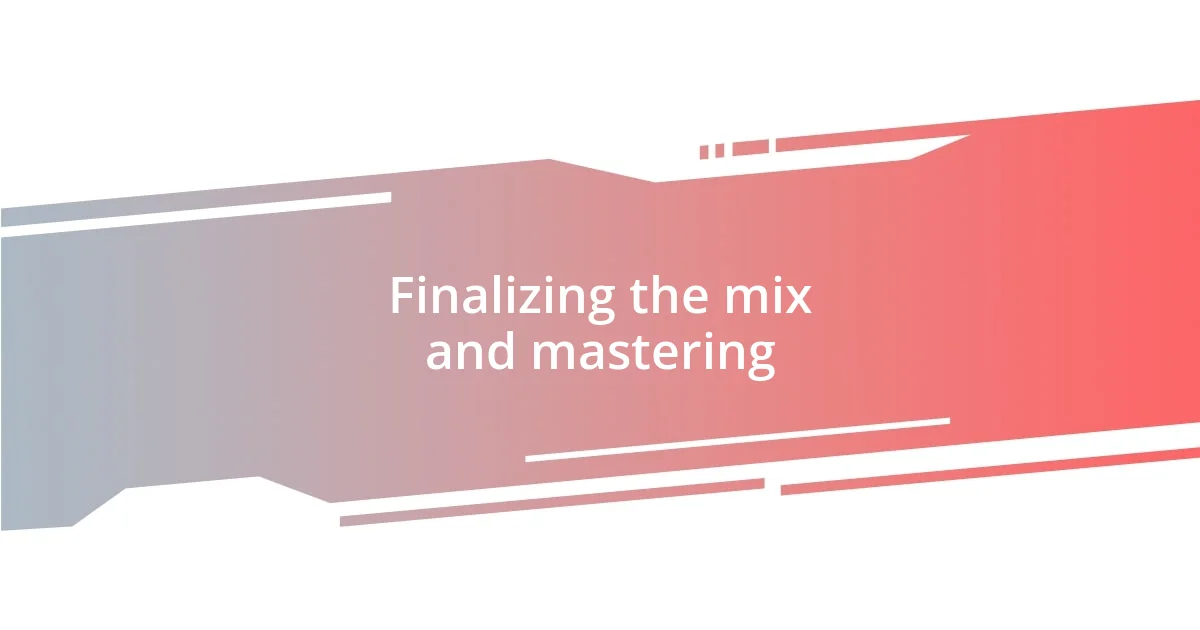
Finalizing the mix and mastering
Finalizing the mix and mastering is where everything comes full circle, and I find it to be one of the most fulfilling parts of the process. When I look back at some of my completed projects, it’s like witnessing a metamorphosis—the mix evolves into something polished and professional. I remember the excitement I felt after my first mastering session; it was as though I was unveiling a hidden treasure that had been lying dormant throughout the mixing process.
One key element that stood out during my mastering phase was the importance of listening in different environments. I recall sitting in my car with my latest track blasting on the speakers, and it hit me how the dynamics shifted compared to my studio monitors. The bass felt impactful, yet the vocals lost a bit of their charm. That realization reminded me that mastering is not just about loudness—it’s about ensuring that every element translates well across various playback systems. Have you ever found yourself making adjustments only to realize they felt different elsewhere? I certainly have.
Ultimately, I’ve learned that mastering requires patience and a keen ear. I often implement subtle EQ adjustments, making certain frequencies pop without overpowering others. It’s a delicate dance where you want the track to scream “professional”—but without losing the intimate essence of the original mix. Reflecting on this, I now understand that mastering is not merely a technical step; it’s an art form that encapsulates everything I’ve poured into the track, making it resonate with listeners in a way that feels both profound and genuine.










